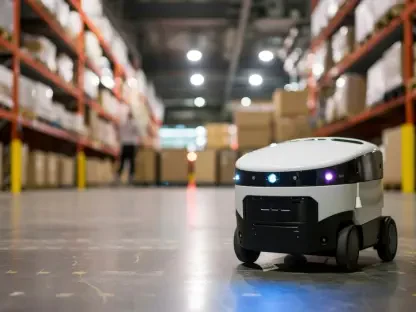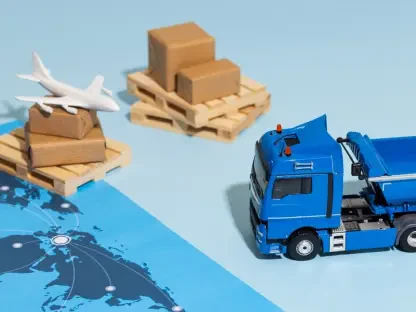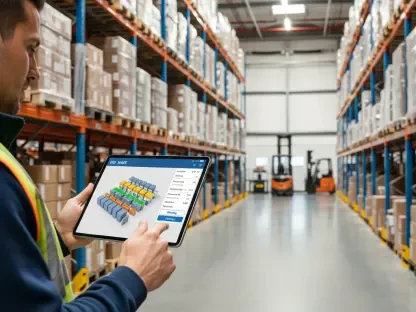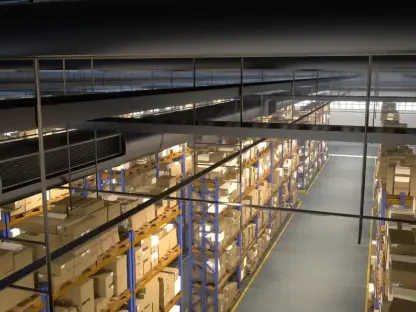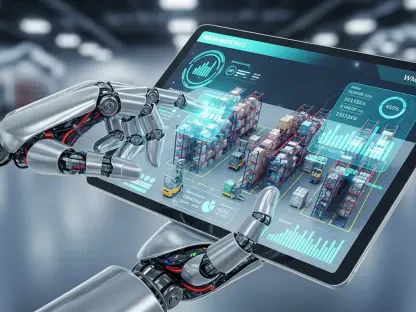The rapid advance of technology is reshaping industries, and warehouses are no exception. The promise of robotics and powered automation transforming logistics is tantalizing, but with great potential come critical decisions. Understanding how to balance the strengths of human workers and automated systems is key to optimizing operations.
Differentiating Robotics from Powered Automation
The Basics of Powered Automation
When we talk about powered automation in warehouses, we refer to machinery designed to complete routine tasks efficiently and predictably. Devices like powered rollers, conveyor belts, pallet-wrapping machines, and auto baggers epitomize this class of equipment. These machines are invaluable primarily because they perform repetitive tasks with minimal variance. The advantage lies in their straightforwardness: their contributions to efficiency and productivity can be precisely measured, making the return on investment (ROI) easier to justify. For instance, conveyor belts handle the straightforward job of moving products between locations, freeing human workers to focus on more complex tasks.
Unlike more advanced automation, powered devices require less costly programming and can be seamlessly integrated into existing workflows. Their repetitive functions mean there’s less need for recalibration, and they can run at a consistent output. Industries and warehousing operations that rely heavily on homogeneous products and steady volume levels often find these simpler technologies indispensable. Incorporating powered automation can lead to significant enhancements in operational efficiency by reducing manual labor for mundane, monotonous tasks. This form of automation is thus essential for many warehouse operations seeking to streamline processes without the complexity and high costs associated with more advanced robotic solutions.
Advanced Robotics
In contrast to the relatively straightforward nature of powered automation, advanced robotics involves a higher degree of complexity and adaptability. Robotics in warehouses includes technology such as robotic arms for picking products, powered carts that follow workers, and multi-function robots capable of mimicking human activities. These systems are designed to operate in nuanced environments but at a higher initial cost and requiring extensive programming. The true value of robotics becomes evident in settings where there is high volume consistency, as robots can work tirelessly on repetitive, standardized tasks without fatigue or error. However, their introduction into variable operations presents significant challenges.
Robotic systems, although transformative, demand specific conditions to function optimally. They are particularly well-suited for operations where tasks are uniform—like automated guided vehicles that transport goods or robotic arms that handle specific types of packaging or item placement. Yet, the ROI for these systems is not as straightforward. Fluctuating processes can strain their efficiency, making it imperative that decision-makers carefully assess the operational context before investing. Robotics may not be the universal solution for every warehousing issue, but in the right conditions, their potential for enhancing productivity and accuracy is substantial.
Key Factors Influencing the Effectiveness of Robotics
Volume Consistency
One of the central tenets to consider when implementing robotics in a warehouse is volume consistency. Robotic systems are engineered to handle specific throughput levels, making them extremely efficient within those parameters. However, these systems can be significantly hampered by sudden spikes or drops in volume. When the volume of goods processed fluctuates wildly, it can lead to periods where robotics sit idle, undermining their cost-effectiveness. Conversely, unexpected surges in volume can overwhelm the system, causing bottlenecks and operational inefficiencies. The investment in robotics thus becomes a double-edged sword if volume consistency is not adequately managed or predicted.
For warehouses with predictable and steady throughput levels, robotics can enhance efficiency dramatically. Automated guided vehicles and sorting systems can facilitate faster and more accurate processing of items, reducing the reliance on human labor for monotonous tasks. However, for businesses experiencing seasonal peaks, like retail centers during holiday shopping periods, the adaptability of human workers often proves more beneficial. Humans can be scaled up quickly to meet increased demand, a flexibility that current robotic systems cannot match. Striking a balance between robotics and human labor in such situations can mitigate the risk while leveraging the advantages of both.
Process Uniformity
Another critical factor influencing the effectiveness of robotics in warehousing is process uniformity. Robotics thrives particularly well in environments where tasks are standardized and repetitive. For example, in operations requiring the consistent placement of the same items into boxes or on assembly lines, robots can greatly increase speed and accuracy. Their ability to perform repetitive tasks without fatigue or error translates into significant savings and efficiencies. However, variability in processes introduces complexities that can hamper robotic performance. Robots may struggle to adapt quickly to changing conditions, leading to inefficiencies and operational friction.
In warehouses where the nature of tasks varies significantly, robots may require frequent reprogramming and recalibration, subsequently driving up operational costs and diminishing their efficiency. Human workers, on the other hand, are naturally more adaptable and can handle a broader range of tasks without the need for constant adjustments. Hence, for operations characterized by high product diversity and variability, relying solely on robots could be counterproductive. In such scenarios, augmenting human labor with collaborative robots or simpler forms of automation might yield better results. Understanding these nuances is crucial for determining the right level of automation.
Product Form Factor
Consistent product form factor is another crucial consideration when evaluating the appropriateness of robotics for warehouse automation. Robots function most effectively in environments where the items being handled are uniform in size and weight. This consistency allows for smoother operations and fewer programming complexities. For instance, in facilities that manage standardized packages or uniformly sized items, robotic systems can sort, pick, and place goods with remarkable efficiency. However, when it comes to handling a wide range of product types and sizes, the practicality of robotics diminishes. Each variation requires different handling protocols, making programming and management more complex and less efficient.
Human workers excel in environments where products are diverse and tasks require a high degree of dexterity and judgment. For example, tasks like removing stickers, gift wrapping, or handling delicate items often exceed the capability of current robotic systems, which lack the nuanced touch and adaptability of human hands. These high-touch activities are crucial in operations like 3PL services for luxury goods and apparel, where the quality and presentation of the product are paramount. Balancing robotics and human labor in such contexts ensures that efficiency gains do not come at the expense of product quality and customer satisfaction.
The Role of Human Workers in Automated Warehouses
Flexibility in Third-Party Logistics
Despite the allure of advanced automation, human workers remain an essential asset in warehousing operations, especially in third-party logistics (3PL) settings. These sectors, particularly those dealing with apparel, accessories, and luxury goods, experience significant volume fluctuations. The flexibility human workers offer in scaling operations up or down quickly is invaluable, especially during peak periods like holiday shopping seasons. Unlike robotic systems, which require consistent volume levels to remain cost-effective, human workers can adapt to varying workloads with little to no downtime, providing a critical buffer against the uncertainties of market demand.
Retail and e-commerce sectors often depend heavily on human workers to meet dynamic operational needs. The ability to hire temporary staff during busy periods or redeploy existing employees to different tasks is a flexibility that robots currently cannot match. This adaptability ensures that supply chain operations remain resilient and responsive to customer needs, even during volatile market conditions. Human workers can also quickly respond to errors, oversee quality control, and make on-the-fly adjustments, thereby complementing automated systems and enriching overall operational efficiency.
Holistic Understanding and Creative Problem-Solving
Human workers bring a breadth of understanding and creativity that robots currently cannot replicate. Their capability to offer holistic insights into warehousing operations is invaluable. They can identify product defects, provide feedback on inefficiencies, and suggest improvements that can enhance customer experiences. In dynamic retail environments, where customer preferences and demand can change rapidly, the ability of human workers to adapt and solve problems creatively is a distinct advantage that robots lack. Tasks requiring personal engagement, like writing gift notes, performing complex kitting, or handling custom packaging, are domains where humans consistently outperform robotic systems.
Robots may handle repetitive tasks efficiently, but they fall short when it comes to jobs that need nuanced decision-making and adaptability. High-touch activities, often involving a degree of manual dexterity and personal touch, are still best managed by human hands. The intrinsic value of human intuition, empathy, and problem-solving skills ensures that warehousing operations not only run smoothly but also maintain high levels of customer satisfaction. As businesses aim for efficiency, the human element’s creative and adaptive capabilities will remain indispensable, especially as complexities in warehousing and logistics increase.
Advancements and Current Limitations of Warehouse Robotics
Present State of Powered Automation
Powered automation is already a cornerstone of efficiency in many warehouses, offering substantial productivity gains and labor cost reductions. Technologies like conveyor belts, automated sorting systems, and pallet-wrapping machines are task-specific but highly effective within their operational scope. They can handle routine activities tirelessly and without error, serving as the backbone for many high-volume warehousing operations. However, their efficiency depends on a clear alignment with the operational needs and constraints of the warehouse. Powered automation systems are less flexible and require steady throughput levels to maximize their ROI, thus fitting well into environments where consistency and repetition are the norm.
Although powered automation excels in many areas, it is not without its limitations. These systems lack the complexity required to handle non-standardized tasks and could necessitate frequent manual intervention when faced with irregular operations. The need for ongoing maintenance and potential downtimes must also be accounted for when evaluating the cost-benefit ratio of such systems. As a result, while powered automation can significantly bolster operational efficiency, it must be integrated thoughtfully into the broader warehousing strategy. Its success hinges on complementing, rather than completely replacing, the human elements in the workforce.
The Future of Robotics
The future of warehouse robotics is promising, characterized by rapid advancements and increasingly sophisticated technologies. However, adoption should be based on a careful assessment of key factors such as volume consistency, process standardization, product uniformity, and the availability of technical expertise. Collaborative robots, or “cobots,” are emerging as a practical solution that offers an incremental approach to increasing productivity. These robots are designed to work alongside human workers, augmenting their capabilities and reducing the need for extensive standardization. Cobots can handle routine tasks while human workers focus on more complex activities, creating a harmonious blend of human and machine labor.
Integrating cobots into existing operations allows businesses to explore the benefits of automation without undergoing a complete overhaul. For example, deploying robots in post-picking activities or package sorting can serve as an efficient entry point into automation. These systems can boost efficiency, reduce labor costs, and improve accuracy in specific tasks. However, it’s essential to evaluate the upfront costs and payback period to ensure alignment with business financial goals and client needs. As the landscape of warehouse robotics continues to evolve, finding the right balance between human labor and robotic assistance will likely offer enhanced efficiency and better customer experiences.
Evaluating the Right Automation Level for Your Operation
Assessing Operational Needs
When considering the implementation of robotics in a warehouse, it is crucial to base decisions on a thorough evaluation of how well these technologies align with your operation’s specific needs. Key considerations include the nature of the tasks performed, the variability in volume, and the uniformity of the products handled. Operations characterized by high-volume, repetitive tasks are prime candidates for robotic automation, offering significant gains in efficiency and accuracy. Conversely, environments with variable volume and diverse product types may benefit more from a hybrid approach, balancing automation with human labor to maintain operational flexibility and adaptability.
This assessment must also consider the level of technical expertise available within the organization. Implementing and maintaining robotic systems require a steep learning curve and ongoing management. Without the requisite technical skills, the potential efficiency improvements may be overshadowed by the challenges of operating these advanced systems. Therefore, businesses should weigh the benefits against the readiness of their workforce to adapt to and manage new technologies. This comprehensive evaluation will ensure that the chosen level of automation is not only effective but also sustainable in the long term.
Integrating Robotics Gradually
The fast-paced evolution of technology is transforming industries, with warehouses being a notable sector undergoing significant changes. The intriguing potential of robotics and automated systems to revolutionize logistics presents a future where efficiency and productivity could be maximized. However, this shift doesn’t come without substantial considerations.
The key challenge lies in strategically balancing the advantages of human labor with the capabilities of automated technology. Human workers bring adaptability, problem-solving, and nuanced decision-making skills—qualities that machines may not yet fully replicate. Conversely, robots can handle repetitive tasks, potentially work around the clock without fatigue, and ensure consistency in operations.
Achieving optimal warehouse efficiency requires a thoughtful integration of both human and robotic strengths. Decision-makers need to assess where automation can enhance productivity without undermining the value that human employees bring. This synergy between human creativity and robotic efficiency is crucial for navigating the future of logistics successfully.


